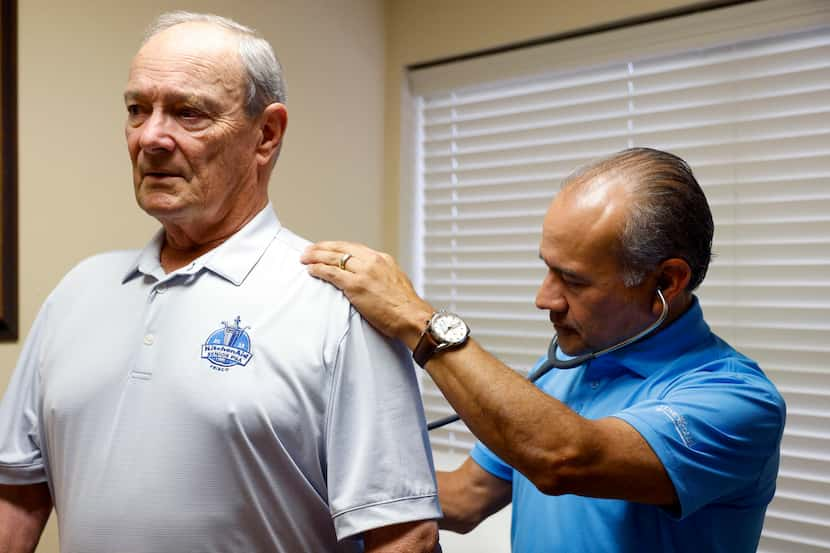Luz Reyes anxiously reviewed the list of pediatricians that her insurance company sent her so she could choose a doctor to care for her 6-year-old daughter.
Reyes, who doesn’t speak English and who arrived in North Texas just a year ago, had trouble finding a Spanish-speaking physician.
“There were very few Latino doctors on the list,” said Reyes. “In Texas, a lot of people speak Spanish — I thought there would be many more doctors I could choose from.”
The situation Reyes faced is all too common: Latinos account for 7% of physicians and surgeons and 9% of all health care practitioners and technicians in the U.S., according to a recent Pew Research Center analysis.
Yet the U.S. Census Bureau indicates there are 63.6 million Hispanics nationwide, which represent 19% of the country’s population. Out of the nation’s 940,254 active physicians, 50,797 are Latino.
That represents 80 Latino doctors for every 100,000 Hispanics in the country.
Latinos account for 11.3% of active physicians in Texas, according to the Association of American Medical Colleges’ 2021 State Workforce Data Report.
Most recent population figures show Hispanic Texans made up 40.2% of the state’s 30.5 million population.
There are 67,182 active doctors in Texas and 7,572 are Latino. That represents 24 Latino doctors for every 100,000 Hispanics in Texas
“In order to have a fair representation, Latino doctors should be 20% of the total doctors in the country, but we are very far from that number,” said Dr. Elena Ríos, president and CEO of the National Hispanic Medical Association.
Ríos’ grandparents are of Mexican origin. She was born in Los Angeles and knows firsthand how difficult it is for a Latino to become a doctor in this country.
Ríos said the lack of quality educational opportunities, economic disparity and the absence of role models help prevent young Hispanics from pursuing a career in the medical field.
“It is a systemic problem, and it starts with education,” said Ríos, who earned her bachelor’s in Human Biology/Public Administration at Stanford University.
“And we have poverty levels in our communities. These poverty levels mean lower-income people who pay less property taxes to support the schools that our kids go to. Latinos go to poorer schools with less money for better teachers and less money for science-type equipment,” Ríos said.
The average cost of medical school is $218,792, or a yearly cost of $54,698, according to the Education Data Initiative, and that’s not including the cost of obtaining a bachelor’s degree.
For Latinos, the average debt is $211,659. Additional costs can also quickly add up, including living expenses and equipment fees.
“Another big part of the problem is that we don’t have role models to relate to. You don’t think about a Latino being a doctor. There are only a few Latino doctors,” Ríos said.
More than just speaking Spanish
About a third of Hispanic Americans say they prefer to see a Spanish-speaking health care provider.
Overall, 35% of Hispanic adults strongly or somewhat prefer seeing a Spanish-speaking doctor or other health care provider for routine care.
A third of Hispanic adults say they prefer a Hispanic doctor for routine care.
Among Hispanic adults, immigrants are much more likely than those born in the U.S. to prefer seeing a Spanish-speaking doctor (58% vs. 12%).
Dr. John Flores, vice speaker of the Texas Medical Association House of Delegates’ policymaking body, said culture matters when people are seeking care.
“My grandparents were from Mexico, and I grew up with that culture, and as a doctor, I know how important it is for patients to relate to someone who speaks their language and understands their culture,” said Flores, an internal medicine specialist in Little Elm. “Patients rely on us to tell them what’s best for them. And if they don’t trust us, how will they follow our advice?”
Fifty percent of Hispanics in the US. say they are unhealthy because they do not understand their doctors’ instructions due to cultural and language differences, according to a 2022 Pew Research Center study.
“That’s a terrible thing,” said Aide Granados, founder of Rosa es Rojo in North Texas. The nonprofit’s mission is dismantling income, language and education barriers to health and well-being for Hispanic women and their families.
Granados is a Mexican immigrant who was diagnosed with breast cancer in 2013.
Her illness and experiences led her to create a blog in Spanish to educate Hispanic women about the actions they can take to care for their health.
The blog evolved and, three years later, became Rosa es Rojo.
“The main barrier to health is language, and that is why we are dedicated to educating women, not only in North Texas but throughout the country, to provide culturally relevant information to eradicate chronic diseases,” said Granados.
Closing the gap
New generations are looking to address the shortage of Hispanic doctors and nurses.
That is the case of Joshua Eric Flores, a father of two who decided the best way to support his community was to become a registered nurse.
“Growing up, I’ve always been a person, friend and family member known to help people and be there for someone,” said Flores, 34. “By choosing the nursing profession, I have the opportunity to do that.”
Flores , a second-generation Mexican American, is the first in his family to enter the medical field, enrolling at Dallas College Northlake campus.
“My grandfather worked for Pacific Union in El Paso, building and fixing the railroad,” he said. “My grandmother worked in a clothing factory. My grandpa did what he had to do to raise my mom and her six brothers and sisters, so I feel very proud of what I’m doing because, at the end of the day, it’s all about hard work and loving what you do.”
Like Flores, Efrain Acosta is another Latino studying to be a nurse at Dallas College.
Acosta, 26, arrived in Dallas from Mexico when he was just 6 months old to undergo reconstructive heart surgery. His parents did not speak English, so they relied on doctors or nurses who spoke Spanish to understand their son’s health status.
Experiencing firsthand the importance of having Spanish-speaking medical personnel in hospitals motivated Acosta to study nursing at the El Centro campus of Dallas College.
“The doctors and nurses studied this wonderful career that brought me health and a second chance at life,” said Acosta, who underwent three surgeries to repair the congenital malformation of his heart.
“What the doctors did for me lit that fire inside me, the passion to get into the medical field. I hope that one day I can give the gift of life to someone, the same gift that the doctors, nurses and medical professionals gave me.”
Acosta said he hopes studying to be a nurse sets an example, so more young Hispanics are encouraged to enter the medical field.
“Hopefully, I can inspire more people who look like me and who come from the same cultural background that I come from,” he said. “I want them to see what I’m doing and what I’m trying to achieve in this field to hopefully inspire future generations of Latinos to follow that same direction.”
CORRECTION, 9:45 p.m., April 26, 2024: An earlier version of this story incorrectly said there are 7,390 Hispanic doctors in Texas. The correct number is 7,572 Hispanic doctors in Texas.
.


/cloudfront-us-east-1.images.arcpublishing.com/dmn/SF26TWVNT5A5PKFIIEPXGAUV7A.JPG)
/cloudfront-us-east-1.images.arcpublishing.com/dmn/JEYVC45T2BZZCL4NUHAXLC5AGY.jpg)
/cloudfront-us-east-1.images.arcpublishing.com/dmn/UFNZCBOX5NBNFA6XG4U7N2662M.jpg)
/cloudfront-us-east-1.images.arcpublishing.com/dmn/QHNQ4MYH6RFKFMOEVCOTE4W6DE.jpg)
/cloudfront-us-east-1.images.arcpublishing.com/dmn/MZIR24MCEZCJFJK2D2ILJS5WTQ.jpg)